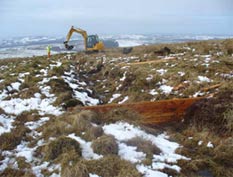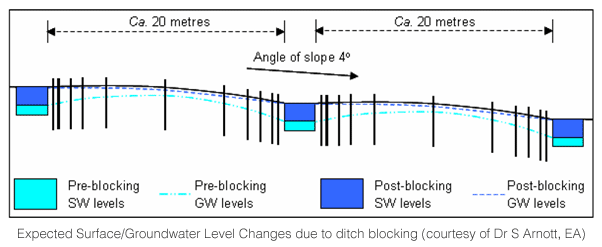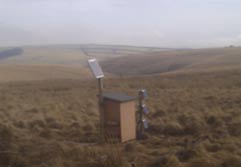Understanding the Effects of Moorland Restoration on Water Quality and Quantity
A project partnership funded by South West Water involving the University of Exeter, Exmoor and Dartmoor National Parks, The Environment Agency, Natural England and English Heritage.
Abstract
RS Hydro have been appointed by Dr Richard Brazier of Exeter University to install equipment on a prestigious monitoring project involving leading edge telemetry equipment to understand the effects of moorland restoration on water quality and flood attenuation...
Equipment Used
Monitoring equipment includes 70 level sensors, 36 INW Conductivity, Depth & Temperature sensors (CTD), rain gauges, 10 ISCO Automatic Water Samplers and an automated real-time telemetry solution using UHF and GPRS technology provided by Adcon Telemetry.
Background
IRS Hydro have been appointed by Dr Richard Brazier of Exeter University to install equipment on a prestigious monitoring project involving leading edge telemetry equipment to understand the effects of moorland restoration on water quality and flood attenuation...
Upland peat bogs are delicate and hydrologically responsive ecosystems that are the UK's largest terrestrial carbon store. Modified catchments such as these have exacerbated flooding issues downstream flooding; the catastrophic floods of Lynmouth (1952) being a prime example. Peaty soils such as upland moors cover 3% of the globe's land surface but store more than 10% of the world's terrestrial carbon. They are therefore a very important global store of carbon.
Changes in land management practices over the last few centuries have also led to significant losses of dissolved organic carbon (DOC) and particulate organic carbon (POC). Together, the loss of moorland habitats and changes to their ecology has meant that there is a much greater awareness of how land management practices affect carbon loss within catchments.
 The Mires restoration project is a collaborative project involving South West Water, Exmoor National Park Authority, Natural England, English Heritage and Exeter University. RS Hydro were appointed as a contractor in 2010. Since 1998 significant areas of ditching on Exmoor National Park have been blocked to restore the wetland areas. However, the exact effects of ditch blocking have never been quantified. The main benefits of ditch blocking include (a) reduction in peak flows and increase in base flows; (b) a reduction in water velocities at peak flows and hence a reduction in gully erosion; (c) an improvement in water quality.
The Mires restoration project is a collaborative project involving South West Water, Exmoor National Park Authority, Natural England, English Heritage and Exeter University. RS Hydro were appointed as a contractor in 2010. Since 1998 significant areas of ditching on Exmoor National Park have been blocked to restore the wetland areas. However, the exact effects of ditch blocking have never been quantified. The main benefits of ditch blocking include (a) reduction in peak flows and increase in base flows; (b) a reduction in water velocities at peak flows and hence a reduction in gully erosion; (c) an improvement in water quality.
As such, a research project of a minimum of three years will look to model the effects of ditch blocking and to therefore provide information to aid decision making regarding the feasibility of moorland restoration, identifying the range of benefits that this will deliver, including the additional sequestration of carbon to mitigate climate change.
The project has a number of work packages. Some of which include the monitoring of the hydrology, ecology, sediment and carbon fluxes over the latest two test catchments of Aclands and Spooners.
Project Monitoring Approach
RS Hydro have been contracted to provide all the monitoring equipment for the three year (possibly longer) monitoring project and to provide a comparative and continual time series dataset (both between sites and different events within each site). Over 70 level sensors have been installed to monitor surface water depth at the outlet of each ditch system and water table depth surrounding each ditch system. Rainfall data will also be recorded at each site and will supplement existing rainfall monitoring by the Environment Agency.
Downstream of each ditch (ten in total), ISCO automatic water samplers will take samples based on water level and/or rainfall thresholds. The samples will be taken and analysed for sediment, DOC and POC fluxes during storm-flow. Regular grab-samples will also be taken to characterise the baseflow fluxes of sediment, DOC and POC through the year due to flow of subsurface water from each site.
By characterising the responses before and after ditch blocking, it should be possible to provide an improved predictive model which can be used for peatland restoration strategies.
This project will also improve understanding and assessment into different restoration techniques and quality of prediction and probabilistic estimates of carbon loss. The project team members have devised a water balanced methodology for assessing the surface water pool-scale and catchment-scale processes. A water balance approach requires the accurate measurement of all inputs and outputs along with any changes in storage for both of the headwater catchments.

Monitoring points have been located adjacent to and radiating outwards from existing ditches and as such will measure the full maximum and minimum range of groundwater fluctuations before and after the ditch blocking. The image below demonstrates the expected pre- and post- surface and groundwater levels.
Monitoring equipment includes 70 level sensors, 36 INW Conductivity, Depth & Temperature sensors (CTD), rain gauges, 10 ISCO Automatic Water Samplers and an automated real-time telemetry solution using UHF and GPRS technology provided by Adcon Telemetry.
For each monitoring location, 6 CTD and 12 level sensors were installed alongside and radiating out from a small length of pre-selected ditch. Due to poor GSM/GPRS coverage, all of the devices were connected using Adcon A723 Series 4 radio telemetry units. In the centre of each catchment an RA440 UHF-GPRS bridge was installed to provide two way communication between all of the radios and also to the outside world using GPRS. All data is continuously uploaded every 15 minutes.
Each radio telemetry unit is self-powered using a 2-watt solar panel (15x12cms!). The telemetry unit has a complete power management program which will ensure that the internal rechargeable is always at its optimum charge but also providing all the power to the attached sensors. Some of the radios have up to 12 down-hole sensors attached. Even this small radio is future proofed enough to attach another 20 sensors should the monitoring requirements be extended at any time.
Losses of DOC/POC and improvements in water quality cannot be physically be measured in-situ due to cost and power requirements. As such, ISCO automatic samplers are being used to capture changes in water quality before, during and after rainfall events. Using rain gauges or level sensors, the monitoring team are able to create algorithms or simple thresholds that can trigger the autosamplers. All Adcon RTUs are automatically adjusted to co-ordinated universal time (UTC) and as such all Adcon RTUs all read to within <1sec of each other. Therefore any exceeded threshold can instruct any one or all of the samplers to take automatic samples at scheduled intervals or for a particular length of time. Obtaining samples throughout the catchments at exactly the same time allows the researchers to be able to make very scientific comparisons which are spatially and temporally defined. This allows researchers globally, for the first time to be able to trigger multiple processes or samplers at the same time whether that be 2 automatic water samplers or 200 water samplers.
RS Hydro were quick to establish that it would be cheaper to downgrade the signal input specification of the sampler and use real-time telemetry to record and control all of the sampling thresholds and sensors remotely. The telemetry system therefore allows all of the control to remain with the remote user rather than having to visit the auto-sampler to change the sampling regime. If the end user wanted to change the parameter that triggered the sampler(s), then this can be done remotely in just a few seconds. In the field, all of the parameters cannot be hardwired because the sensors and parameters may be several kilometers apart.
 In terms of installation, each monitoring location required a small pole to attach the telemetry unit and solar panel. The sampler was housed in a small wooden kiosk. Competitive equivalents would have required solar panels 20-50x the size plus, a car battery and a dedicated kiosk for each telemetry unit. Adcon equipment therefore has further multiple cost savings. There is no requirement to visit site other than to collect the sample bottles from the auto-samplers. The data portal will also tell you when and how many samples have been taken therefore allowing the end user to decide when to collect the water samples.
In terms of installation, each monitoring location required a small pole to attach the telemetry unit and solar panel. The sampler was housed in a small wooden kiosk. Competitive equivalents would have required solar panels 20-50x the size plus, a car battery and a dedicated kiosk for each telemetry unit. Adcon equipment therefore has further multiple cost savings. There is no requirement to visit site other than to collect the sample bottles from the auto-samplers. The data portal will also tell you when and how many samples have been taken therefore allowing the end user to decide when to collect the water samples.
The implications of this technology allows the end user, engineer or researcher to measure and control small and large, simple and complex monitoring networks automatically. All alarms, whether it be data delay, battery alarms, threshold exceedances can be communicated by either email, SMS, voicemail or visually on the data portal.
